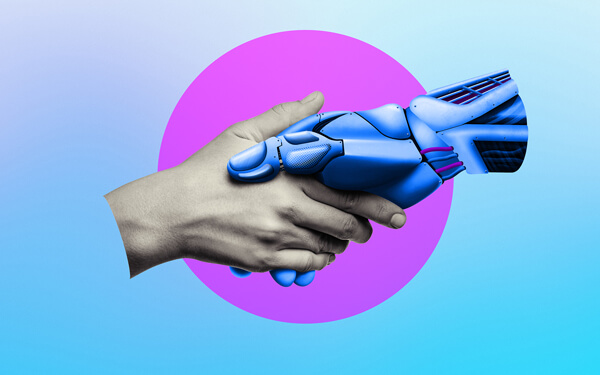Human after all

Editorial

Unless you’re a fan of their music, you might not know that “Human After All” is the title of the third album of electronic music duo Daft Punk. Its central message, amid a robotic beat, is that despite technological advancement, at the center we remain human beings with all our unique talents and vulnerabilities. This is something business executives are becoming increasingly aware of. Norms and expectations for staff wellbeing have been changing rapidly, and the explosion of artificial intelligence (AI) has raised big questions — and concerns — about the role of humans in the workplace, and indeed, the future of human intelligence itself. So, we wanted to devote this issue of Prism to ourselves — humans!
A good place to start is to ask the leaders of the world’s biggest companies. We’re pleased to bring you the results of our 2024 Global CEO Insights Study, which confirms that CEOs recognize clearly the need to focus much more on people and skills in an uncertain, AI-transformed future. Reskilling just moved to the very top of the corporate agenda.
Zeroing in on innovation and R&D, we bring you another groundbreaking ADL study into the digitally and AI-enabled lab of the future, and we have a clear conclusion: it’s people centric. It’s all about making people the best innovators they can possibly be. How well AI is integrated with human intelligence — rather than AI itself — will be what determines the world-beating enterprises of the future.
In 2024, people between 18 and 30 years of age, known as “Gen Z,” will make up over a quarter of the global workforce. As the first digital native generation from birth, having grown up in a very different world to that of the late 20th century, they are not like the rest of us. In our third article, we explore how organizations can attract and retain this key cohort, so crucial for the future.
You might think that healthcare is, by definition, human centric, but in fact, that’s not always the case. Our next article looks at how pharmaceutical companies can become more patient centric, a growing determinant of success in a highly competitive marketplace.
Our final articles look at two more important aspects of the AI future. Firstly, we look at what AI means for the future capabilities of software development organizations, whether in-house or service providers. And secondly, based on in-depth studies by ADL’s future technology institute, Blue Shift, we address a topic that’s often rather superficially covered: AI risk. We look at the range of AI risks, and what companies can do to make sure they properly manage their exposure.
To round things off, it’s our pleasure to bring you an exclusive interview with Jeremy Nixon, CEO of one of the world’s fastest-growing maritime shipping companies, Singapore-based ONE. Jeremy shares some fascinating insights about how to grow a successful and sustainable global business — with a special emphasis on “being very human.”
We hope you enjoy the issue!
Rick Eagar
Chief Editor, Prism
Arthur D. Little
DATE

Editorial
Unless you’re a fan of their music, you might not know that “Human After All” is the title of the third album of electronic music duo Daft Punk. Its central message, amid a robotic beat, is that despite technological advancement, at the center we remain human beings with all our unique talents and vulnerabilities. This is something business executives are becoming increasingly aware of. Norms and expectations for staff wellbeing have been changing rapidly, and the explosion of artificial intelligence (AI) has raised big questions — and concerns — about the role of humans in the workplace, and indeed, the future of human intelligence itself. So, we wanted to devote this issue of Prism to ourselves — humans!
A good place to start is to ask the leaders of the world’s biggest companies. We’re pleased to bring you the results of our 2024 Global CEO Insights Study, which confirms that CEOs recognize clearly the need to focus much more on people and skills in an uncertain, AI-transformed future. Reskilling just moved to the very top of the corporate agenda.
Zeroing in on innovation and R&D, we bring you another groundbreaking ADL study into the digitally and AI-enabled lab of the future, and we have a clear conclusion: it’s people centric. It’s all about making people the best innovators they can possibly be. How well AI is integrated with human intelligence — rather than AI itself — will be what determines the world-beating enterprises of the future.
In 2024, people between 18 and 30 years of age, known as “Gen Z,” will make up over a quarter of the global workforce. As the first digital native generation from birth, having grown up in a very different world to that of the late 20th century, they are not like the rest of us. In our third article, we explore how organizations can attract and retain this key cohort, so crucial for the future.
You might think that healthcare is, by definition, human centric, but in fact, that’s not always the case. Our next article looks at how pharmaceutical companies can become more patient centric, a growing determinant of success in a highly competitive marketplace.
Our final articles look at two more important aspects of the AI future. Firstly, we look at what AI means for the future capabilities of software development organizations, whether in-house or service providers. And secondly, based on in-depth studies by ADL’s future technology institute, Blue Shift, we address a topic that’s often rather superficially covered: AI risk. We look at the range of AI risks, and what companies can do to make sure they properly manage their exposure.
To round things off, it’s our pleasure to bring you an exclusive interview with Jeremy Nixon, CEO of one of the world’s fastest-growing maritime shipping companies, Singapore-based ONE. Jeremy shares some fascinating insights about how to grow a successful and sustainable global business — with a special emphasis on “being very human.”
We hope you enjoy the issue!
Rick Eagar
Chief Editor, Prism
Arthur D. Little
TABLE OF CONTENTS

Optimistic global CEOs focus on people and skills in an AI future
Embracing the opportunities that artificial intelligence (AI) and talent together can unlock, CEOs are looking beyond the current instability, and increasingly confident about the future prospects for their organizations and the wider economy. Two-thirds are highly positive about the global outlook over the next three to five years, a major increase from 2023. Given that global tensions have worsened over the last 12 months, with conflict in the Middle East, disruptions to Red Sea supply chains, and the continuing war in Ukraine, this optimism is dramatic and heartening.

The people-centric lab of the future
As the world grapples with global mega-challenges, innovation[1] has never been more necessary. We need breakthrough innovation to solve pressing issues around energy, the environment, and social and health challenges. At the same time, and equally importantly, companies have to deal with a business world typified by increased complexity and accelerated time frames. Together these mean innovation must deliver more breakthroughs, rather than only incremental improvements, with more flexibility and responsiveness and at greater speed.

The future workforce
Generation Z (widely known as Gen Z), encompassing those born between 1997 and 2012, is anticipated to make up over one-quarter of the global workforce by 2025, according to the World Economic Forum. As the first digitally native and globally connected generation, Gen Z brings distinctive skills and capabilities to organizations, making their recruitment and retention essential for sustained business success in the era of digital transformation and artificial intelligence (AI).

Why patient centricity is key to long-term pharma company success
Patient centricity seems to be an obvious focus for pharmaceutical companies. After all, their core business is to develop drugs and treatments to meet specific patient needs. Yet, patient centricity is not evident across the end-to-end pharma value chain, from identifying unmet patient needs through drug discovery and development to product availability and treatment. For example, on average, 30% of patients leave clinical trials before their scheduled treatment completion date, often because of the high burden of the trials on their lives.

Software revolution
One of the front-row candidates for disruption by artificial intelligence (AI) is software product and service development. AI is already leading to a paradigm shift in aspects such as coding, architecture, security, service management and ticketing, and personalization, providing new opportunities and risks. But the implications go well beyond new products and services and improved development approaches, into how software enterprises need to transform themselves across the board, from strategy and organization through to capabilities, resources, and ways of working.

Be careful out there
By now, business executives are well aware that using artificial intelligence (AI), especially generative AI (GenAI) such as ChatGPT, brings with it certain risks as well as benefits. Apart from the commonly cited existential risk of a future artificial general intelligence posing a threat to mankind, there are plenty of less severe but more likely risks. Those that most people have read about already are possible biases in GenAI’s outputs, as well as its propensity to “hallucinate” on occasion.

“Big enough to survive and small enough to care — we can do it!”
Operating out of Singapore, Ocean Network Express, branded as “ONE,” was formed in April 2018 by merging the three competing container shipping business units of Japanese parent companies NYK, MOL, and K-Line. At the time, many commentators highlighted the challenges of such a large, complex integration. Yet just five and a half years later, ONE has become one of the most profitable and successful companies in the industry, with net income of approximately US $50 billion over the past five years.





